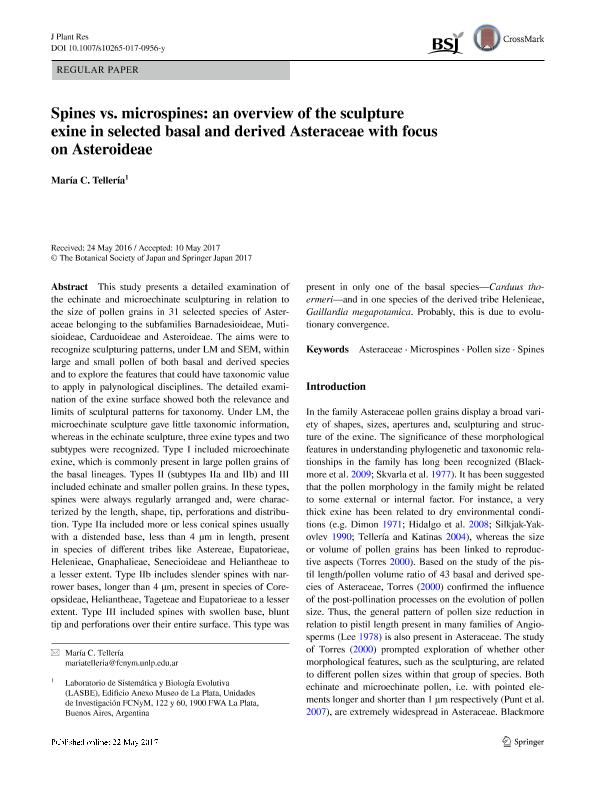Mostrar el registro sencillo del ítem
dc.contributor.author
Tellería, María Cristina

dc.date.available
2018-06-21T17:02:12Z
dc.date.issued
2017-11
dc.identifier.citation
Tellería, María Cristina; Spines vs. microspines: an overview of the sculpture exine in selected basal and derived Asteraceae with focus on Asteroideae; Springer Tokyo; Journal of Plant Research; 130; 6; 11-2017; 1023-1033
dc.identifier.issn
0918-9440
dc.identifier.uri
http://hdl.handle.net/11336/49571
dc.description.abstract
This study presents a detailed examination of the echinate and microechinate sculpturing in relation to the size of pollen grains in 31 selected species of Asteraceae belonging to the subfamilies Barnadesioideae, Mutisioideae, Carduoideae and Asteroideae. The aims were to recognize sculpturing patterns, under LM and SEM, within large and small pollen of both basal and derived species and to explore the features that could have taxonomic value to apply in palynological disciplines. The detailed examination of the exine surface showed both the relevance and limits of sculptural patterns for taxonomy. Under LM, the microechinate sculpture gave little taxonomic information, whereas in the echinate sculpture, three exine types and two subtypes were recognized. Type I included microechinate exine, which is commonly present in large pollen grains of the basal lineages. Types II (subtypes IIa and IIb) and III included echinate and smaller pollen grains. In these types, spines were always regularly arranged and, were characterized by the length, shape, tip, perforations and distribution. Type IIa included more or less conical spines usually with a distended base, less than 4 µm in length, present in species of different tribes like Astereae, Eupatorieae, Helenieae, Gnaphalieae, Senecioideae and Heliantheae to a lesser extent. Type IIb includes slender spines with narrower bases, longer than 4 µm, present in species of Coreopsideae, Heliantheae, Tageteae and Eupatorieae to a lesser extent. Type III included spines with swollen base, blunt tip and perforations over their entire surface. This type was present in only one of the basal species—Carduus thoermeri—and in one species of the derived tribe Helenieae, Gaillardia megapotamica. Probably, this is due to evolutionary convergence.
dc.format
application/pdf
dc.language.iso
eng
dc.publisher
Springer Tokyo

dc.rights
info:eu-repo/semantics/openAccess
dc.rights.uri
https://creativecommons.org/licenses/by-nc-sa/2.5/ar/
dc.subject
Asteraceae
dc.subject
Microspines
dc.subject
Pollen Size
dc.subject
Spines
dc.subject.classification
Otras Ciencias Biológicas

dc.subject.classification
Ciencias Biológicas

dc.subject.classification
CIENCIAS NATURALES Y EXACTAS

dc.title
Spines vs. microspines: an overview of the sculpture exine in selected basal and derived Asteraceae with focus on Asteroideae
dc.type
info:eu-repo/semantics/article
dc.type
info:ar-repo/semantics/artículo
dc.type
info:eu-repo/semantics/publishedVersion
dc.date.updated
2018-06-21T12:58:19Z
dc.journal.volume
130
dc.journal.number
6
dc.journal.pagination
1023-1033
dc.journal.pais
Japón

dc.journal.ciudad
Tokyo
dc.description.fil
Fil: Tellería, María Cristina. Consejo Nacional de Investigaciones Científicas y Técnicas; Argentina. Universidad Nacional de La Plata. Facultad de Ciencias Naturales y Museo. Laboratorio de Sistemática y Biología Evolutiva; Argentina
dc.journal.title
Journal of Plant Research

dc.relation.alternativeid
info:eu-repo/semantics/altIdentifier/doi/https://dx.doi.org/10.1007/s10265-017-0956-y
dc.relation.alternativeid
info:eu-repo/semantics/altIdentifier/url/https://link.springer.com/article/10.1007%2Fs10265-017-0956-y
Archivos asociados
